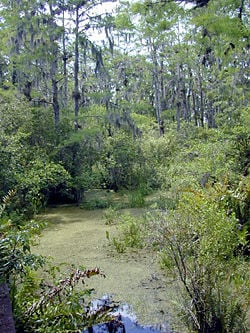Swamp
- This article is about the wetland type (a landform). For other uses of the term "swamp", see swamp (disambiguation).
A swamp is a wetland that features permanent inundation of large areas of land by shallow bodies of water, generally with a substantial number of hummocks, or dry-land protrusions. In the USA, swamps are usually regarded as including a large amount of woody vegetation, but elsewhere this may not necessarily apply, such as in African swamps dominated by papyrus.
By contrast a marsh in the USA is a wetland without woody vegetation, or elsewhere, a wetland without woody vegetation which is shallower and has less open water surface than a swamp. A mire (or quagmire) is a low-lying wetland of deep, soft soil or mud that sinks underfoot.
Swamps are generally characterized by very slow-moving waters, often rich in tannins from decaying vegetation. They are usually associated with adjacent rivers or lakes. In some cases, rivers become swamps for a distance. Swamps are features of areas with very low topographic relief, although they may be surrounded by mountains.
The most famous swamps in the United States are the Everglades, Okefenokee Swamp and the Great Dismal Swamp. The Okefenokee is located in extreme southeastern Georgia and extends slightly into northeastern Florida. The Great Dismal Swamp lies in extreme southeastern Virginia and extreme northeastern North Carolina. Both are National Wildlife Refuges. Another swamp area, Reelfoot Lake of extreme western Tennessee, was created by the New Madrid earthquake of 1812. Caddo Lake, the Great Dismal and Reelfoot are swamps that are centered at large lakes. Swamps are often called bayous in the southeastern United States, especially in the Gulf Coast region.
Swamps are characterized by rich biodiversity and specialized organisms. For instance, southeastern U.S. swamps, such as those mentioned above, feature trees such as the Bald cypress and Water tupelo, which are adapted to growing in standing water, and animals such as the American alligator.
A common species name in biological nomenclature is the Latin palustris, meaning "of the swamp". Examples of this are Quercus palustris (pin oak) and Thelypteris palustris (marsh fern).
Heraldry
A swamp appears in the coat of arms of Gesturi, Italy.
List of major swamps
Africa
Asia
North America
- Great Black Swamp, United States
- Great Dismal Swamp, United States
- Great Pocomoke Swamp also known as Great Cypress Swamp, Maryland, United States
- Okefenokee Swamp, Georgia/Florida, United States
- Reelfoot Lake, United States
- Big Cypress National Preserve, Florida, United States
- Limberlost, Indiana, United States
- Honey Island Swamp, Louisiana, United States
- Great Swamp National Wildlife Refuge, New Jersey, United States
- Atchafalaya National Wildlife Refuge, Louisiana, United States
South America
See also
- Will o' the wisp
- Marsh gas
- Slough
- Hydrogen sulfide
- Marsh
- Muck
- Peat
- Aquatic plant
- Bog
Credits
New World Encyclopedia writers and editors rewrote and completed the Wikipedia article in accordance with New World Encyclopedia standards. This article abides by terms of the Creative Commons CC-by-sa 3.0 License (CC-by-sa), which may be used and disseminated with proper attribution. Credit is due under the terms of this license that can reference both the New World Encyclopedia contributors and the selfless volunteer contributors of the Wikimedia Foundation. To cite this article click here for a list of acceptable citing formats.The history of earlier contributions by wikipedians is accessible to researchers here:
The history of this article since it was imported to New World Encyclopedia:
Note: Some restrictions may apply to use of individual images which are separately licensed.

